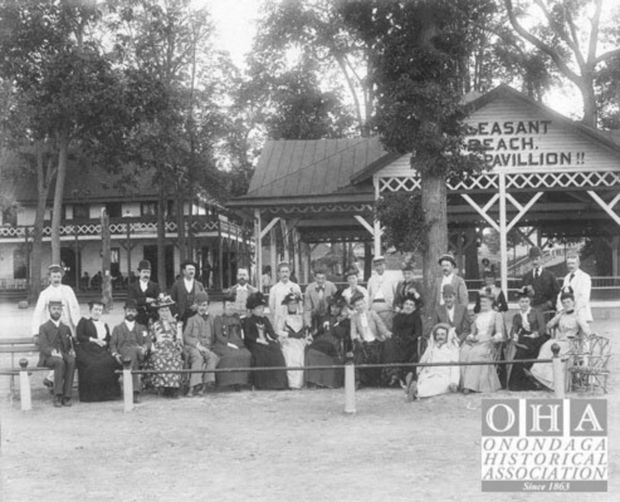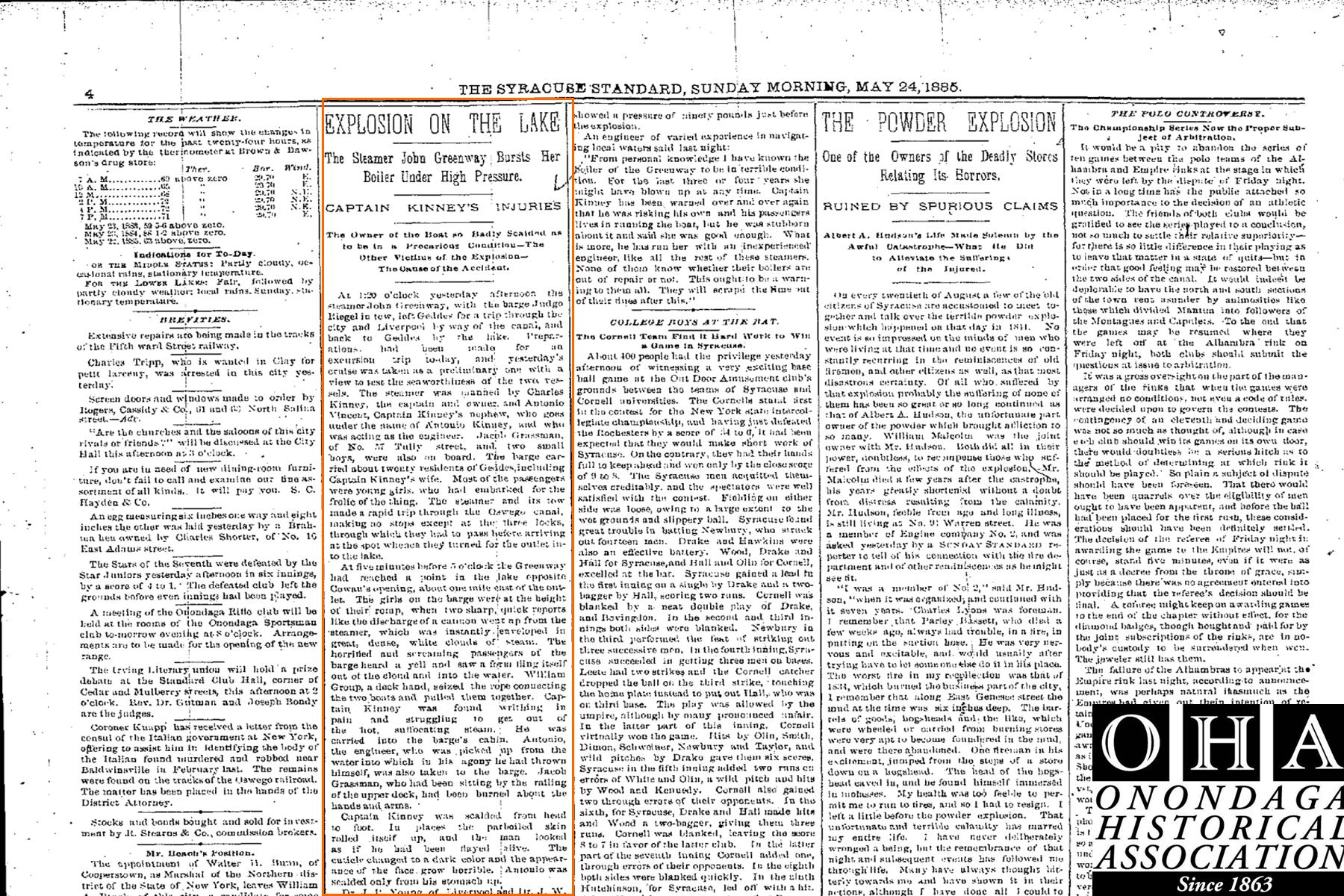
 On May 23rd, 1885, the steamer John Greenway, which ferried passengers to the resorts on the north end of Onondaga Lake, including Cowan’s Grove (later renamed Pleasant Beach, photo above) was taking its first trip of the season on Onondaga Lake, towing the barge “Judge Riegel” with 20 or so residents of Geddes aboard. The steamer was to pass through Syracuse and Liverpool through the canal and back to Geddes through Onondaga Lake. Just before 5 p.m., a mile east of the outlet, the boiler of the steamer exploded. The captain and, Charles Kinney, and engineer were seriously burned and died a short time later despite the efforts of Dr. J. R. Young and J.W. Knapp. The terrified passengers, which included Knney’s wife, were rescued by nearby boaters. “The boat itself suffered little damage apart from its machinery,” according to the Syracuse Standard report from the following day (photo, left). The same story reported that the cause of the explosion was the steam chimney was “blown out by the exhaust water and a great body of steam accumulating and finding no egress blew out the plates.”
On May 23rd, 1885, the steamer John Greenway, which ferried passengers to the resorts on the north end of Onondaga Lake, including Cowan’s Grove (later renamed Pleasant Beach, photo above) was taking its first trip of the season on Onondaga Lake, towing the barge “Judge Riegel” with 20 or so residents of Geddes aboard. The steamer was to pass through Syracuse and Liverpool through the canal and back to Geddes through Onondaga Lake. Just before 5 p.m., a mile east of the outlet, the boiler of the steamer exploded. The captain and, Charles Kinney, and engineer were seriously burned and died a short time later despite the efforts of Dr. J. R. Young and J.W. Knapp. The terrified passengers, which included Knney’s wife, were rescued by nearby boaters. “The boat itself suffered little damage apart from its machinery,” according to the Syracuse Standard report from the following day (photo, left). The same story reported that the cause of the explosion was the steam chimney was “blown out by the exhaust water and a great body of steam accumulating and finding no egress blew out the plates.”
Here’s the New York Times Report from later that week:
“The excursion steamer JOHN GREENWAY, which runs on Onondaga Lake and the canal, started yesterday afternoon from its landing in Geddes for a trip across the lake. The steamer had in tow the barge JUDGE RIEGEL, on board of which was about 20 residents of Geddes, who had been invited to take a ride. The steamer was commanded by CHARLES KINNE, the Captain and owner, who has run the boat on the lake for the past 12 years. The boat was to begin its Summer excursioni trips today, and the Captain started out yesterday on a preliminary trip to test the machinery. A few minutes before 5 o’clock, when the steamer had reached a point about a mile east of the outlet, two sharp reports were heard, and the steamer was instantly enveloped in clouds of steam. The passengers on the barge heard a shout, and saw a form fling itself out of the cloud into the water. WILLIAM GRAUGH, a deckhand, seized the rope connecting the two boats and pulled them together. Capt. KINNE was found writhing in pain and struggling to get out of the suffocating steam. He was carried into the barge’s cabin. ANTONIO KINNE, the engineer, who was picked up from the water into which he had thrown himself, was also taken to the barge. JACOB GRASSMAN, who had been sitting by the railing of the upper deck, had been burned on the hands and arms. Capt. KINNE was scalded from head to foot. In places the skin rolled itself up, and the man looked as if he had been flayed alive. DR. J. R. YOUNG, of Liverpool, and DR. J. W. KNAPP, of Geddes, were called as soon as possible. The helpless steamer and barge had drifted a quarter of a mile down the lake, toward the southern shore. A few rowboats put out from Liverpool and Salina and took away the passengers. Capt. KINNE lingered in great agony until 5 o’clock this morning, when he died. ANTONIO, the engineer, is badly burned, and it is thought fatally. The flue plates of the boiler and the steam chimney were blown out. The boiler had been declared to be unsafe a year ago, and was known by competent engineers to be in a bad condition. The Captain had been repeatedly warned that he was risking his own life and those of his passengers in running the boat, but he insisted that she was safe. The boat was run by an utterly incompetent engineer and a stubborn Captain. She had carried thousands of passengers every Summer, and experienced engineers express wonder that her boiler had not exploded long ago.”

